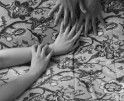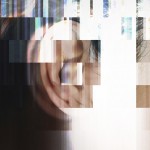The Hand in Nature: Margaret LeJeune
The Hand in Nature: a week of photographs that manipulates how we see and foresee our environment.
Photographs help us process what is happening in the world, and this week we’ll be following photographers whose work inspects humans’ impact on the earth. More importantly, the posts will focus on how each photographer uses their hand in the manipulation of imagery. Many of the photographers’ works curiously demonstrate our history and future relationship with the earth.
Today we will discuss Margaret LeJeune‘s photographic series that explore the climate crisis through investigations of water, watersheds and wetlands. In LeJeune’s work we see a curiosity about nature and the unpredictable ways an artist can explore notions of wonder. LeJeune allows the aesthetic approach for each project to be determined by her subject matter. Through collaborations with scientists and residencies at research stations, her creative practice is founded in interdisciplinary research. While LeJeune’s work aims to be informative, it is also beautiful and poetic. She employs simple to more complex visual methods to bring awareness regarding her subject matters and to allow her audience to visualize these environmental destructions. As an aquaphile, and mariner who has spent months at a time at sea, water is her constant muse. Thoreau’s Sink, The Watershed Triptych, and Thirteen Hours to Fall deal with climate change topics that specifically relate to the ecosystems between land and water or exist there within.
For example her series Thoreau’s Sink, created during an artist residency at the University of Wisconsin Trout Lake Station – Center for Limnology, consists of sixty-six lumen prints representing the variety of species of Crystal Bog, a peatland in Northern Wisconsin. Currently kept in a box to protect them from UV light, the prints will be installed in a large grid pattern at the research station so that science faculty, artists, and students can observe shifts in these images over time. Lumen prints are created by setting objects onto a piece of silver gelatin paper and exposing it to the sun. If not fixed, these images will slowly fade over time. Intentionally not fixing them, LeJeune’s goal is to have them disappear, as a metaphor and reminder that Crystal Bog and other wetlands are quickly disappearing. Wetlands currently make up just three percent of all land, but these areas hold twice as much carbon as all standing forests. Like the fading prints lost forever, once gone, these wetlands habitats and their resident species will be lost. The work takes on a spiritual nature similar to Thoreau’s. The work appears inobtrusive at first but is powerful upon reflection.
Le Jeune’s The Watershed Triptych is not as quiet as her Thoreau’s Sink series. It is made up of three acrylic-faced photographs that feel more like sculptures than most two-dimensional works. The imagery includes USGS maps of the three most significant agricultural watersheds in the United States. Over the last 30 years the outflow from these watersheds have contributed to significant red tide algal blooms. LeJeune uses the brilliant blue light from bioluminescent dinoflagellates, colloquially known as sea sparkle, to illuminate the maps. These organisms are the same marine life that generate red tide blooms. The increase in powerful storms and subsequent flooding contaminates the waterways with runoff from factory farming. The circular presentation of the images references the materiality of the petri dish and flasks used to culture these organisms in LeJeune’s studio. In March, the Royal Photographic Society awarded Margaret the 2023 Woman Science Photographer of the Year for this project.
In her latest project, Thirteen Hours to Fall, LeJeune examines the climate crisis by investigating contemporary and future littoral zones on the mid-Atlantic coast. Littoral zones are described as transitional land between the marsh and open waters. Cleverly LeJeune bases the project’s name on the time between high and low tides; these locations are only truly revealed for thirteen hours within a day. Colonial timber industries, plantation farming, and climate change have extensively altered this particular region of North Carolina. LeJeune’s work sheds light on how colonial capitalists, the ensuing extraction economy, and rising sea levels have dramatically altered this landscape over the last 400 years. While this is a work-in-progress, LeJeune has spent the last two years employing various visual strategies to explore this landscape, including photomontage, video, salt prints created with brackish water collected in the ghost forests, and sculptural book forms. She intends to further explore this project during at her 2023 Changing Climate Residency at the Santa Fe Art Institute this spring.
Climate grief, curiosity, and environmental interactions are all strong drivers for LeJeune’s work. Her work at times reflects the ephemeral characteristics of nature and shows us what usually goes unseen. She reprocesses the ecological makeup that usually is not seen. Instead of being only surface-deep, LeJeune creates with an essential introspection of how to look inquisitively with the future in mind.
Margaret LeJeune has a lot of work to share, and you can find a more expansive collection of her work on her website.
Follow LeJeune on Instagram at @margaret_lejeune.
Margaret LeJeune is an image-maker, curator, and educator from Rochester, New York (USA). She received an MFA from Visual Studies Workshop. Working predominantly with photographic-based mediums, LeJeune explores our precarious relationship to the natural world. Her work has been widely exhibited at institutions including The Griffin Museum of Photography (USA), The Center for Fine Art Photography (USA), ARC Gallery (USA), Circe Gallery Cape Town (South Africa), Science Cabin (South Korea), and Umbrella Arts (USA). LeJeune has been invited to create work at several residency programs which foster collaboration between the arts and sciences including the Global Nomadic Art Project – The Ephemeral River, University of Notre Dame Research Center, Trout Lake Research Station, Huron Mountain Wildlife Foundation – Ives Lake Field Station, and the 2023 Changing Climate Residency at Santa Fe Art Institute. She has been awarded two Puffin Foundation Artist Grants, The Sally A. Williams Artist Grant, and was recently named the 2023 Woman Science Photographer of the Year by the Royal Photographic Society. Her works have been published in numerous publications including Culture, Community, and Climate: Conversations from art.earth press and Embodied Forest from ecoartspace. LeJeune currently serves as Professor of Art and Design in Photography at Bradley University in Peoria, Illinois.
Sarah Knobel is a photographer, video and installation artist that works with everyday items to find new ways to identify our relationship with ideas of the natural, artificial, beautiful and repulsive. Her work has been featured in exhibitions nationally and internationally, which includes Miami, Seattle, Portland, Kansas City, Washington DC, Germany, Belgium, Korea and Greece. Sarah holds an MFA in Photography from the Design Architecture Art and Planning Program at the University of Cincinnati and a BFA in Studio Art from Texas State University. She is currently an Assistant Professor of Art at St. Lawrence University in Canton, New York.
Follow Sarah on Instagram at @sknobel.
Posts on Lenscratch may not be reproduced without the permission of the Lenscratch staff and the photographer.
Recommended
-
Chelsea Tan: before the light escapes us…July 7th, 2024
-
Josh Raftery: Start the Story at the EndJune 28th, 2024
-
THE CENTER AWARDS: ME&EVE GRANT: ANNA REEDMay 22nd, 2024
-
Earth Week: Casey Lance Brown: KudzillaApril 25th, 2024
-
Earth Month: Photographers on Photographers, Dennis DeHart in conversation with Laura PlagemanApril 16th, 2024




































































